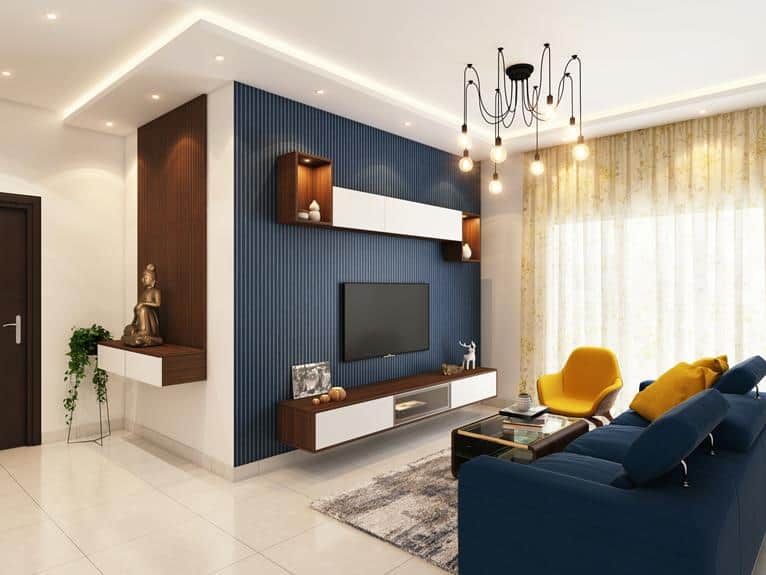Whether the foyer and living room should be the same color depends on the desired effect. Using the same color can create a cohesive look and a smooth transition between the two areas. However, different colors can define the spaces and give them unique identities.
Consider the architecture, natural light, and overall design when choosing colors for these areas. This discussion examines the benefits and considerations of color selection to achieve either a unified or distinct space.
Analyzing Color Continuity
In analyzing color continuity, it’s important to consider the effect of color transitions between areas such as the foyer and living room on the home’s overall look and feel. Consistent color use in interior design ensures that adjoining rooms work well together. A unified color theme throughout a home can make spaces seem larger and more connected.
However, when matching colors, it’s crucial to consider what atmosphere and function each room should have. Using the same color can connect spaces, but varying shades or tones can still separate areas while keeping a cohesive feel. This approach allows for a distinction between the foyer as an entrance and the living room as a social space.
Successful color continuity balances unity and distinction. Choosing related colors and tones can create unity without being repetitive. Options include monochromatic schemes or complementary colors, aiming for a smooth transition that improves the overall living experience.
Impact on Spatial Perception
Color choices in home design can have a significant impact on how we perceive space. One effective technique to create the illusion of a larger area is to paint the foyer and living room the same color. This is particularly useful for small or narrow entryways, as it can make them appear more spacious.
On the other hand, using different colors in these spaces can define them as separate areas. By selecting colors that complement each other, homeowners can create a cohesive look while enhancing the sense of moving from one space to another.
In addition to color, wall treatments and flooring materials also play a role in spatial perception. For example, using textured wallpaper in the foyer and a solid color in the living room can distinguish the spaces while maintaining a sense of unity. Furthermore, choosing different types of flooring can mark the transition between the foyer and living area.
Ultimately, whether to blend or separate the color scheme between the foyer and living room depends on the desired effect on space perception. Homeowners should carefully select colors that not only match their personal style but also fulfill their practical needs.
Harmonizing Transitional Spaces
To create a smooth transition between the home’s entrance and the living room, it is important to carefully select colors and design elements. Homeowners must balance the visual flow with the need to give each space its own feel. Using related colors with slight variations can differentiate areas subtly while maintaining continuity.
When picking colors for the hallway and living room, choose shades that are complementary. For example, pairing a dark tone in the foyer with a lighter, neutral shade in the living room can preserve unity yet distinguish each space. An accent wall in the foyer, perhaps in a vibrant color like emerald green, can offer a bold welcome that coordinates with the living room palette.
White trim can act as a unifying feature throughout the house, linking the foyer and living room visually. Different flooring in the foyer and living area can provide design flexibility and still result in a cohesive look.
Ultimately, the choice of using the same or varying colors for the foyer and living room depends on individual taste and the intended outcome. Strategic color and design decisions can help homeowners establish an inviting and visually appealing space.
Embracing Color Diversity
Using a variety of colors can improve the look and feel of a home’s entryway and living area. Homeowners often paint their walls in neutral colors, but adding a bold color to the foyer can make a strong visual statement. A light color in the living room can create a calm space, while a darker color in the foyer provides a warm welcome.
When choosing colors for these areas, it’s important to ensure they complement each other. A distinct color in the foyer can separate it from the living room without needing a physical divider. White trim can help maintain visual consistency.
Colors can also draw attention to architectural details, like a high ceiling or staircase. Using different colors can add depth and character to a home.
The objective is to balance the colors so they work together, creating a space that is both unified and vibrant. The combination of light and bold colors should be harmonious and offer contrast, resulting in an appealing and unique space.
Practical Color Selection Tips
When choosing colors for a home, it’s important to consider how the foyer and living room colors work together. The foyer, often less lit, should have a lighter color to feel welcoming. The living room can use warmer tones to seem inviting or cooler colors for a calming effect. If the foyer and living room are connected without a clear separation, using gradient or complementary colors can help define the spaces without clashing.
If the foyer is near other rooms like the dining room, ensure the color scheme is consistent to make transitions smooth and possibly make the space seem larger. A bold color in the foyer can set the home’s decor tone, while the living room can have neutral tones for a more relaxing atmosphere.
To unify the spaces, use consistent design elements like white trim or similar textures. This approach allows for different colors while keeping the overall design cohesive.





